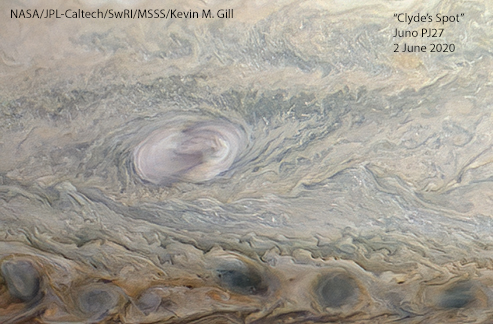A rare methane-bright outbreak in Jupiter’s South Temperate domain
- 1Astronomical Society of Southern Africa, Centurion, South Africa (clyde@icon.co.za)
- 2British Astronomical Association, London, UK
- 3ALPO-Japan
- 4NASA JPL, CaltTech, Pasadena,USA
- 5Planetary Science Institute, Tuscon, AZ, USA
- 6Independent Amateur, Sydney, Australia
Introduction
Energetic, high altitude eruptions in Jupiter’s atmosphere, which we refer to as outbreaks, are not uncommon in the North and South Equatorial Belts (NEB and SEB) as well as higher latitudes. However, few have been observed in the Temperate regions. An intense methane-bright outbreak in the South Temperate Belt (STB) latitudes was observed by the lead author on 2020 May 31. Although the outbreak, which would become known as “Clyde’s Spot” in the Pro-Am planetary community, faded quite rapidly in methane wavelengths, developments were monitored by the amateur community over the following weeks. The outbreak occurred two days prior to the Juno Perijove 27 flyby, and close Pro-Am collaboration resulted in very high-resolution images of the outbreak being obtained by the JunoCam imager during the flyby.
Outbreak detection
The outbreak occurred in the southern part of a pre-existing small white spot at 31⁰S, embedded in a pale grey streak, and suspected of being a cyclonic vortex and was detected early on the 31 May. Observations from other amateurs confirmed that the outbreak had occurred within the previous 10 hours. It was only slightly brighter than before in RGB, but extremely bright in the 0.89 micron CH4 absorption band. It remained methane-bright though much weaker over the following rotations, and from June 1 onwards appeared to consist of two (individually unresolved) parts which moved gradually apart up to June 6, mostly in the E-W direction but with slight cyclonic rotation from June 1-3.
NASA Juno PJ27
The JunoCam images on June 2 showed Clyde’s spot as an unusual, roughly oval, bright spot in RGB and CH4, with brighter arcs in its E and W ends that were the pair of methane-bright spots in ground-based images. The spot does not show popup clouds but is marked by numerous concentric arcs which could represent gravity waves in the expanding high-level white cloud (A. Casely). Surrounding streaks confirm that it is within a strongly cyclonic vortex, although it may be over-riding those streaks on the S side.
Outcome of the outbreak
Amateur images from June 2-3, only small spots at the site of the initial eruption. From June 3 to June 13, v-hi-res images showed at least one white spot and one very dark spot; they changed rapidly in detail, possibly with cyclonic motion. No obvious changes have developed outside this site, apart from appearance of thin blue-grey lines close to the STBn and STBs jets for ~13 deg west Clyde’s spot. In methane images, by June 11 the appearance had reverted to a short oblique methane-dark streak with no bright spot, as it was before the eruption.
Cycles of STB Structured sectors
This spot erupted tens of degrees east of the only large anticyclonic oval in this domain, Oval BA. Small cyclonic spots have repeatedly arisen here in the last 20 years and expand to form structured sectors of the STB, which persist as large cyclonic segments for several years until they catch up with Oval BA from the west side. Although a new structured sector has been anticipated, it was only ground-based images early in 2020 that showed two new features which could be its precursors. One was a small, very dark spot ~40⁰ east of BA, which persists; the other was the faint oblique streak, centred on a tiny white spot, ~80⁰ east of BA. Clyde’s spot erupted in this latter white spot. Therefore, this eruption may be a previously unknown feature of a cyclonic vortex in this transitional location and stage. Although the outbreak was very short-lived, implying similar outbreaks might be occurring unobserved, its occurrence in this location suggests that it was significant.
The outbreak in the context of previous outbreaks.
The only similar methane-bright outbreaks previously recorded in the cyclonic STB latitudes were in large structured sectors at the end of their life: the so-called STB Remnant in 2010 and the STB Ghost in 2018 [1,2]. These generated rapidly expanding disturbances that converted these long cyclonic circulations into dark turbulent STB segments. In contrast, Clyde’s spot, being in a very compact cyclonic vortex, has remained confined in its immediate vicinity and has not developed further (as of 2020 June 22).
Similar plume outbreaks occasionally occur in small but stable cyclonic vortices in the SEB. This was the way in which at least two recent SEB Revivals [2007, 2010] and two mid-SEB outbreaks [1979, 2017] began, and it is possible that they always do so.
Conclusion
This was a single, very energetic plume eruption within the small cyclonic spot. Over the following days the plume expanded locally, and disturbance continued at the original site, but there is no evidence of substantial wider changes. This contrasts with the results of the similar eruptions within larger circulations, which were rapidly converted into turbulent dark STB segments. Clyde’s spot was a brief event, never conspicuous in visible light, but detected because of frequent monitoring with methane images. It may represent a previously unknown type of eruption in a small cyclonic spot in the early stages of development of a STB structured sector. An update will be provided in the presentation.
Figures:
‘Clyde’s spot’ in 889 nm methane band (left) and RGB (right): (Top) initial detection from C.F. on 31 May 2020; (Bottom) closeups from JunoCam on 2 June 2020.

References:
How to cite: Foster, C., Rogers, J., Mizumoto, S., Orton, G., Hansen, C., Momary, T., and Casely, A.: A rare methane-bright outbreak in Jupiter’s South Temperate domain, Europlanet Science Congress 2020, online, 21 Sep–9 Oct 2020, EPSC2020-196, https://doi.org/10.5194/epsc2020-196, 2020.

